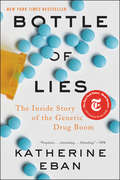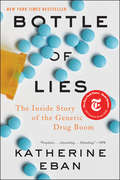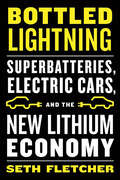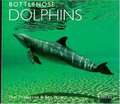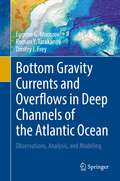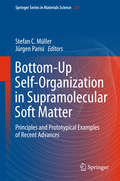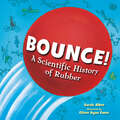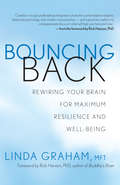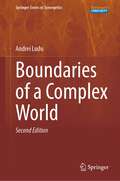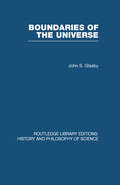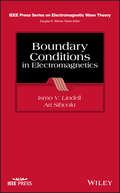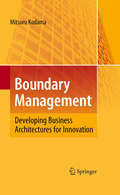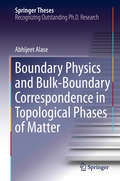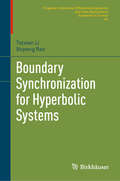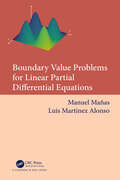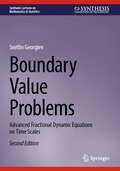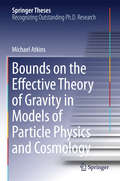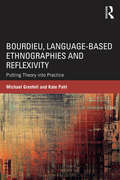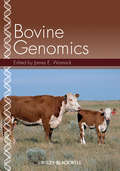- Table View
- List View
Bottle of Lies: The Inside Story of the Generic Drug Boom
by Katherine EbanFrom an award-winning journalist, an explosive narrative investigation of the generic drug boom that reveals fraud and life-threatening dangers on a global scale—The Jungle for pharmaceuticalsMany have hailed the widespread use of generic drugs as one of the most important public-health developments of the twenty-first century. Today, almost 90 percent of our pharmaceutical market is comprised of generics, the majority of which are manufactured overseas. We have been reassured by our doctors, our pharmacists and our regulators that generic drugs are identical to their brand-name counterparts, just less expensive. But is this really true?Katherine Eban’s Bottle of Lies exposes the deceit behind generic-drug manufacturing—and the attendant risks for global health. Drawing on exclusive accounts from whistleblowers and regulators, as well as thousands of pages of confidential FDA documents, Eban reveals an industry where fraud is rampant, companies routinely falsify data, and executives circumvent almost every principle of safe manufacturing to minimize cost and maximize profit, confident in their ability to fool inspectors. Meanwhile, patients unwittingly consume medicine with unpredictable and dangerous effects.The story of generic drugs is truly global. It connects middle America to China, India, sub-Saharan Africa and Brazil, and represents the ultimate litmus test of globalization: what are the risks of moving drug manufacturing offshore, and are they worth the savings? A decade-long investigation with international sweep, high-stakes brinkmanship and big money at its core, Bottle of Lies reveals how the world’s greatest public-health innovation has become one of its most astonishing swindles.
Bottle of Lies: The Inside Story of the Generic Drug Boom
by Katherine EbanA NEW YORK TIMES BESTSELLER New York Times 100 Notable Books of 2019New York Public Library Best Books of 2019 Kirkus Reviews Best Health and Science Books of 2019Science Friday Best Books of 2019 New postscript by the authorFrom an award-winning journalist, an explosive narrative investigation of the generic drug boom that reveals fraud and life-threatening dangers on a global scale—The Jungle for pharmaceuticalsMany have hailed the widespread use of generic drugs as one of the most important public-health developments of the twenty-first century. Today, almost 90 percent of our pharmaceutical market is comprised of generics, the majority of which are manufactured overseas. We have been reassured by our doctors, our pharmacists and our regulators that generic drugs are identical to their brand-name counterparts, just less expensive. But is this really true?Katherine Eban’s Bottle of Lies exposes the deceit behind generic-drug manufacturing—and the attendant risks for global health. Drawing on exclusive accounts from whistleblowers and regulators, as well as thousands of pages of confidential FDA documents, Eban reveals an industry where fraud is rampant, companies routinely falsify data, and executives circumvent almost every principle of safe manufacturing to minimize cost and maximize profit, confident in their ability to fool inspectors. Meanwhile, patients unwittingly consume medicine with unpredictable and dangerous effects.The story of generic drugs is truly global. It connects middle America to China, India, sub-Saharan Africa and Brazil, and represents the ultimate litmus test of globalization: what are the risks of moving drug manufacturing offshore, and are they worth the savings? A decade-long investigation with international sweep, high-stakes brinkmanship and big money at its core, Bottle of Lies reveals how the world’s greatest public-health innovation has become one of its most astonishing swindles.
Bottled Lightning: Superbatteries, Electric Cars, and the New Lithium Economy
by Seth FletcherLithium batteries may hold the key to an environmentally sustainable, oil-independent future. From electric cars to a "smart" power grid that can actually store electricity, letting us harness the powers of the sun and the wind and use them when we need them, lithium—a metal half as dense as water, found primarily in some of the most uninhabitable places on earth—has the potential to set us on a path toward a low-carbon energy economy. In Bottled Lightning, the science reporter Seth Fletcher takes us on a fascinating journey, from the salt flats of Bolivia to the labs of MIT and Stanford, from the turmoil at GM to cutting-edge lithium-ion battery start-ups, introducing us to the key players and ideas in an industry with the power to reshape the world. Lithium is the thread that ties together many key stories of our time: the environmental movement; the American auto industry, staking its revival on the electrification of cars and trucks; the struggle between first-world countries in need of natural resources and the impoverished countries where those resources are found; and the overwhelming popularity of the portable, Internet-connected gadgets that are changing the way we communicate. With nearly limitless possibilities, the promise of lithium offers new hope to a foundering American economy desperately searching for a green-tech boom to revive it.
Bottlenose Dolphins (WorldLife Library)
by Paul Thompson Ben WilsonIntelligent, graceful and approachable, dolphins have long been among the worlds favorite sea creatures. Of all the dolphin species, the bottlenose is best known and loved. But bottlenose dolphins are more than television stars and aquarium performers. In Bottlenose Dolphins readers will voyage under the sea with researchers Paul Thompson and Ben Wilson, who are studying dolphins off the coast of Scotland. The authors explain the bottlenose dolphins oceanic habitat and range, and delve into their complex social relationships. They also share their concerns for the future of these beloved seafarers and suggest steps to protect them. Stunning color photographs accompany their insights.
Bottom Gravity Currents and Overflows in Deep Channels of the Atlantic Ocean: Observations, Analysis, and Modeling
by Eugene G. Morozov Roman Y. Tarakanov Dmitry I. FreyThis book is dedicated to the analysis of bottom waters flows through underwater channels of the Atlantic Ocean. The study is based on recent observations of the authors, analysis of historical data, numerical modeling, and literature review. For example, studying both the measurements from the World Ocean Circulation experiment in the 1990s and recent measurements reveals the decadal variations of water properties in the ocean.Seawater is cooled at high latitudes, descends to the ocean bottom, and slowly flows to the tropical latitudes and further. This current is slow in the deep basins, but intensifies in the abyssal channels connecting the basins. The current overflows submarine topographic structures and sometimes forms deep cataracts when water descends over slopes by several hundred meters. The flow of Antarctic Bottom Water (AABW) is studied on the basis of CTD sections combined with Lowered Acoustic Doppler Profiling (LADCP) carried out annually, and long-term moored measurements of currents. This book is a collection of oceanographic data, interpretation, and analysis, which can be used by field oceanographers, specialists in numerical modeling, and students who specialize in oceanography.
Bottom-Up Self-Organization in Supramolecular Soft Matter: Principles and Prototypical Examples of Recent Advances (Springer Series in Materials Science #217)
by Stefan C. Müller Jürgen ParisiThis book presents the general concepts of self-organized spatio-temporal ordering processes. These concepts are demonstrated via prototypical examples of recent advances in materials science. Particular emphasis is on nano scale soft matter in physics, chemistry, biology and biomedicine. The questions addressed embrace a broad spectrum of complex nonlinear phenomena, ranging from self-assembling near the thermodynamical equilibrium to dissipative structure formation far from equilibrium. Their mutual interplay gives rise to increasing degrees of hierarchical order. Analogues are pointed out, differences characterized and efforts are made to reveal common features in the mechanistic description of those phenomena.
Bottoms Up and the Devil Laughs: A Journey Through the Deep State
by Kerry HowleyA NATIONAL BOOK CRITICS CIRCLE AWARD FINALIST • A NEW YORK TIMES TOP TEN BOOK OF THE YEAR • A VANITY FAIR BEST BOOK OF THE YEAR&“Riveting and darkly funny and in all senses of the word, unclassifiable.&” – The New York TimesA wild, humane, and hilarious meditation on post-privacy America—from the acclaimed author of ThrownWho are you? You are data about data. You are a map of connections—a culmination of everything you have ever posted, searched, emailed, liked, and followed. In this groundbreaking work of narrative nonfiction, Kerry Howley investigates the curious implications of living in the age of the indelible. Bottoms Up and the Devil Laughs tells the true story of intelligence specialist Reality Winner, a lone young woman who stuffs a state secret under her skirt and trusts the wrong people to help. After printing five pages of dangerous information she was never supposed to see, Winner finds herself at the mercy of forces more invasive than she could have possibly imagined.Following Winner&’s unlikely journey from rural Texas to a federal courtroom, Howley maps a hidden world, drawing in John Walker Lindh, Lady Gaga, Edward Snowden, a rescue dog named Outlaw Babyface Nelson, and a mother who will do whatever it takes to get her daughter out of jail. Howley&’s subjects face a challenge new to history: they are imprisoned by their past selves, trapped for as long as the Internet endures. A soap opera set in the deep state, Bottoms Up and the Devil Laughs is a free fall into a world where everything is recorded and nothing is sacred, from a singular writer unafraid to ask essential questions about the strangeness of modern life.
Bounce!: A Scientific History of Rubber
by Sarah AlbeeEver wondered what makes rubber bounce? Or why it's stretchy? And WHY is rubber so . . . rubbery?! Learn the facinating science and history behind this ubiquitous material!With sidebars, graphics, fun facts, and more, the history of rubber reveals plenty of fascinating secrets and surprises. Elementary school readers will discover that early balls didn't bounce; that people in the rainforest made waterproof gear from rubber thousands of years before Europeans got into the act; and that sneakers, bicycles, and cars created demand for more and more rubber!Back matter includes a time line and a bit about the complicated implications of harvesting rubber.
Bouncing Back: Rewiring Your Brain for Maximum Resilience and Well-Being
by Linda GrahamResilience is the ability to face and handle life’s challenges, whether everyday disappointments or extraordinary disasters. While resilience is innate in the brain, over time we learn unhelpful patterns, which then become fixed in our neural circuitry. But science is now revealing that what previously seemed hardwired can be rewired, and Bouncing Back shows us how. With powerful, time-tested exercises, Linda Graham guides us in rebuilding our core well-being and disaster-proofing our brains.
Boundaries of a Complex World (Springer Series in Synergetics)
by Andrei LuduThe 2nd edition of this book provides novel topics and studyies in boundaries of networks and Big Data Systems.The central theme of this book is the extent to which the structure of the free dynamical boundaries of a system controls the evolution of the system as a whole. Applying three orthogonal types of thinking - mathematical, constructivist and morphological, it illustrates these concepts using applications to selected problems from the social and life sciences, as well as economics. In a broader context, it introduces and reviews some modern mathematical approaches to the science of complex systems. Standard modeling approaches (based on non-linear differential equations, dynamic systems, graph theory, cellular automata, stochastic processes, or information theory) are suitable for studying local problems. However they cannot simultaneously take into account all the different facets and phenomena of a complex system, and new approaches are required to solve the challenging problem of correlations between phenomena at different levels and hierarchies, their self-organization and memory-evolutive aspects, the growth of additional structures and are ultimately required to explain why and how such complex systems can display both robustness and flexibility. This graduate-level text addresses a broader interdisciplinary audience, keeping the mathematical level essentially uniform throughout the book, and involving only basic elements from calculus, algebra, geometry and systems theory.
Boundaries of the Universe (Routledge Library Editions: History & Philosophy of Science)
by John S GlasbyThe boundaries of space exploration are being pushed back constantly, but the realm of the partially understood and the totally unknown is as great as ever. Among other things this book deals with astronomical instruments and their application, recent discoveries in the solar system, stellar evolution, the exploding starts, the galaxies, quasars, pulsars, the possibilities of extraterrestrial life and relativity.
Boundary Conditions in Electromagnetics (IEEE Press Series on Electromagnetic Wave Theory)
by Ismo V. Lindell Ari SihvolaA comprehensive survey of boundary conditions as applied in antenna and microwave engineering, material physics, optics, and general electromagnetics research. Boundary conditions are essential for determining electromagnetic problems. Working with engineering problems, they provide analytic assistance in mathematical handling of electromagnetic structures, and offer synthetic help for designing new electromagnetic structures. Boundary Conditions in Electromagnetics describes the most-general boundary conditions restricted by linearity and locality, and analyzes basic plane-wave reflection and matching problems associated to a planar boundary in a simple-isotropic medium. This comprehensive text first introduces known special cases of particular familiar forms of boundary conditions — perfect electromagnetic conductor, impedance, and DB boundaries — and then examines various general forms of boundary conditions. Subsequent chapters discuss sesquilinear boundary conditions and practical computations on wave scattering by objects defined by various boundary conditions. The practical applications of less-common boundary conditions, such as for metamaterial and metasurface engineering, are referred to throughout the text. This book: Describes the mathematical analysis of fields associated to given boundary conditions Provides examples of how boundary conditions affect the scattering properties of a particle Contains ample in-chapter exercises and solutions, complete references, and a detailed index Includes appendices containing electromagnetic formulas, Gibbsian 3D dyadics, and four-dimensional formalism Boundary Conditions in Electromagnetics is an authoritative text for electrical engineers and physicists working in electromagnetics research, graduate or post-graduate students studying electromagnetics, and advanced readers interested in electromagnetic theory.
Boundary Element Methods in Nonlinear Fluid Dynamics: Developments in boundary element methods - 6
by P. K. Banerjee L. MorinoThis volume demonstrates that boundary element methods are both elegant and efficient in their application to time dependent time harmonic problems in engineering and therefore worthy of considerable development.
Boundary Management: Developing Business Architectures for Innovation
by Mitsuru KodamaThis book presents the concept of business architecture and optimizing processes as a corporate system based on multiple corporate case studies, including Sony, NTT-DATA, NTT-DoCoMo, Toyota, Honda, Omron, Takara, Recruit, First Retailing, Panasonic and Canon.
Boundary Physics and Bulk-Boundary Correspondence in Topological Phases of Matter (Springer Theses)
by Abhijeet AlaseThis thesis extends our understanding of systems of independent electrons by developing a generalization of Bloch’s Theorem which is applicable whenever translational symmetry is broken solely due to arbitrary boundary conditions. The thesis begins with a historical overview of topological condensed matter physics, placing the work in context, before introducing the generalized form of Bloch's Theorem. A cornerstone of electronic band structure and transport theory in crystalline matter, Bloch's Theorem is generalized via a reformulation of the diagonalization problem in terms of corner-modified block-Toeplitz matrices and, physically, by allowing the crystal momentum to take complex values. This formulation provides exact expressions for all the energy eigenvalues and eigenstates of the single-particle Hamiltonian. By precisely capturing the interplay between bulk and boundary properties, this affords an exact analysis of several prototypical models relevant to symmetry-protected topological phases of matter, including a characterization of zero-energy localized boundary excitations in both topological insulators and superconductors. Notably, in combination with suitable matrix factorization techniques, the generalized Bloch Hamiltonian is also shown to provide a natural starting point for a unified derivation of bulk-boundary correspondence for all symmetry classes in one dimension.
Boundary Plasma Physics: An Accessible Guide to Transport, Detachment, and Divertor Design (Springer Series on Atomic, Optical, and Plasma Physics #123)
by Fulvio MilitelloThis book serves as an introduction to boundary plasma physics, providing an accessible entry point to the topic of plasma exhaust in magnetic confinement devices. While it delivers a concise, rigorous, and comprehensive account of all the major scientific topics relevant to those working on the subject, it also remains accessible and easy to consult due to its modular and compact structure. Beginning with the basic kinetic and fluid descriptions of plasma, and advancing through plasma-surface interactions, filamentary transport and plasma detachment, to conclude with a discussion of divertor configurations, this book represents a necessary and timely addition to the literature on the fast-growing field of boundary plasma physics. It will appeal to experienced theoreticians or experimentalists looking to enter the field as well as graduate students wishing to learn about it.
Boundary Synchronization for Hyperbolic Systems (Progress in Nonlinear Differential Equations and Their Applications #94)
by Tatsien Li Bopeng RaoWithin this carefully presented monograph, the authors extend the universal phenomenon of synchronization from finite-dimensional dynamical systems of ordinary differential equations (ODEs) to infinite-dimensional dynamical systems of partial differential equations (PDEs). By combining synchronization with controllability, they introduce the study of synchronization to the field of control and add new perspectives to the investigation of synchronization for systems of PDEs. With a focus on synchronization for a coupled system of wave equations, the text is divided into three parts corresponding to Dirichlet, Neumann, and coupled Robin boundary controls. Each part is then subdivided into chapters detailing exact boundary synchronization and approximate boundary synchronization, respectively. The core intention is to give artificial intervention to the evolution of state variables through appropriate boundary controls for realizing the synchronization in a finite time, creating a novel viewpoint into the investigation of synchronization for systems of partial differential equations, and revealing some essentially dissimilar characteristics from systems of ordinary differential equations. Primarily aimed at researchers and graduate students of applied mathematics and applied sciences, this text will particularly appeal to those interested in applied PDEs and control theory for distributed parameter systems.
Boundary Value Problems for Linear Partial Differential Equations
by Manuel Mañas Luis Martínez AlonsoBoundary value problems play a significant role in modeling systems characterized by established conditions at their boundaries. On the other hand, initial value problems hold paramount importance in comprehending dynamic processes and foreseeing future behaviors. The fusion of these two types of problems yields profound insights into the intricacies of the conduct exhibited by many physical and mathematical systems regulated by linear partial differential equations.Boundary Value Problems for Linear Partial Differential Equations provides students with the opportunity to understand and exercise the benefits of this fusion, equipping them with realistic, practical tools to study solvable linear models of electromagnetism, fluid dynamics, geophysics, optics, thermodynamics and specifically, quantum mechanics. Emphasis is devoted to motivating the use of these methods by means of concrete examples taken from physical models. Features No prerequisites apart from knowledge of differential and integral calculus and ordinary differential equations. Provides students with practical tools and applications Contains numerous examples and exercises to help readers understand the concepts discussed in the book.
Boundary Value Problems: Advanced Fractional Dynamic Equations on Time Scales (Synthesis Lectures on Mathematics & Statistics)
by Svetlin GeorgievThis new edition presents an updated and expanded exploration of boundary value problems for fractional dynamic equations on arbitrary time scales, including Caputo fractional dynamic equations, impulsive Caputo fractional dynamic equations, and impulsive Riemann-Liouville fractional dynamic equations. In a new chapter, the author introduces time scale calculus and fractional time scale calculus. The book also covers initial value problems, boundary value problems, initial boundary value problems for each type of equation. The author provides integral representations of the solutions and proves the existence and uniqueness of the solutions. This second edition includes new and updated examples and problems.
Boundary and Eigenvalue Problems in Mathematical Physics
by Hans SaganThis well-known text uses a limited number of basic concepts and techniques — Hamilton's principle, the theory of the first variation and Bernoulli's separation method — to develop complete solutions to linear boundary value problems associated with second order partial differential equations such as the problems of the vibrating string, the vibrating membrane, and heat conduction. It is directed to advanced undergraduate and beginning graduate students in mathematics, applied mathematics, physics, and engineering who have completed a course in advanced calculus. In the first three chapters, Professor Sagan introduces Hamilton's principle and the theory of the first variation; he then discusses the representation of the vibrating string, the vibrating membrane and heat conduction (without convection) by partial differential equations. Bernoulli's separation method and infinite series solutions of homogeneous boundary value problems are introduced as a means for solving these problems. The next three chapters take up Fourier series, self-adjoint boundary value problems, Legendre polynomials, and Bessel functions. The concluding three chapters address the characterization of eigenvalues by a variational principle; spherical harmonics, and the solution of the Schroedinger equation for the hydrogen atom; and the nonhomogeneous boundary value problem. Professor Sagan concludes most sections of this excellent text with selected problems (solutions provided for even-numbered problems) to reinforce the reader's grasp of the theories and techniques presented.
Bounders
by Monica TeslerIn the tradition of Michael Vey and The Unwanteds, twelve-year-old Jasper and his friends are forced to go up against an alien society in this first book in a brand-new adventure series!Thirteen years ago, Earth Force--a space-military agency--discovered a connection between brain structure and space travel. Now they've brought together the first team of cadets, called Bounders, to be trained as high-level astronauts. Twelve-year-old Jasper is part of this team being sent out into space. After being bullied back on Earth, Jasper is thrilled to have something new and different to do with other kids who are more like him. While learning all about the new technologies and taking classes in mobility--otherwise known as flying with jetpacks--Jasper befriends the four other students in his pod and finally feels like he has found his place in the world. But then Jasper and his new friends learn that they haven't been told everything about Earth Force. They weren't brought to space for astronaut training, but to learn a new, highly classified brain-sync technology that allows them to manipulate matter and quantum bound, or teleport. And it isn't long before they find out this new technology was actually stolen from an alien society. When Jasper and his friends discover the truth about why Earth Force needs them, they are faced with a choice: rebel against the academy that brought them together, or fulfill their duty and protect the planet at all costs.
Bounds on the Effective Theory of Gravity in Models of Particle Physics and Cosmology (Springer Theses)
by Michael AtkinsThe effective theory of quantum gravity coupled to models of particle physics is being probed by cutting edge experiments in both high energy physics (searches for extra dimensions) and cosmology (testing models of inflation). This thesis derives new bounds that may be placed on these models both theoretically and experimentally. In models of extra dimensions, the internal consistency of the theories at high energies are investigated via perturbative unitarity bounds. Similarly it is shown that recent models of Higgs inflation suffer from a breakdown of perturbative unitarity during the inflationary period. In addition, the thesis uses the latest LHC data to derive the first ever experimental bound on the size of the Higgs boson's non-minimal coupling to gravity.
Bourdieu, Language-based Ethnographies and Reflexivity: Putting Theory into Practice
by Kate Pahl Michael GrenfellOffering a unique and original perspective on Bourdieu, language-based ethnographies,and reflexivity, this volume provides a nuanced, in-depth discussion of the complex relationship between these interconnected topics and their impact in real-world contexts. Part I opens the book with an overview of the historical background and development of language-based ethnographic research and Bourdieu’s work in this space. Part II presents a series of case studies that highlight a Bourdieusian perspective and demonstrate how reflexivity impacts language-based ethnography. In each study, Bourdieu’s conceptual framework of reflexively-informed objectivity examines the ways in which the studies themselves were constructed and understood. Building on Parts I and II, the concluding set of chapters in Part III unpacks the messiness of the theory and practice of language-based ethnography, and provides insights into what reflexivity means for Bourdieu and in practical contexts. Arguing for a greater reflexive understanding in research practice, this volume sets an agenda for future literacy and language research.
Bovine Genomics
by James E. WomackThe genetic information being unlocked by advances in genomic and high throughput technologies is rapidly revolutionizing our understanding of developmental processes in bovine species. This information is allowing researchers unprecedented insight into the genetic basis of key traits. Bovine Genomics is the first book to bring together and synthesize the information learned through the bovine genome sequencing project and look at its practical application to cattle and dairy production. Bovine Genomics opens with foundational chapters on the domestication of cattle and traditional Mendelian genetics. Building on these chapters, coverage rapidly moves to quantitative genetics and the advances of whole genome technologies. Significant coverage is given to such topics as epigenetics, mapping quantitative trail loci, genome-wide association studies and genomic selection in cattle breeding. The book is a valuable synthesis of the field written by a global team of leading researchers. Providing wide-ranging coverage of the topic, Bovine Genomic, is an essential guide to the field. The basic and applied science will be of use to researchers, breeders, and advanced students.
Bovine Maternal Support and Embryo Survival
by Aureliano HernándezIn this work, the endocrine and histological preparations of the uterine environment for embryo/foetus survival are covered, through compilation of relevant research results pertaining ovarian, uterine and placental changes. Also, a general overview of the ovarian cycle, uterine changes, development of the placenta, nutritional and immunological mechanisms of embryo acceptance and protection, as well as some of the most outstanding causes of embryo/foetus mortality. Each chapter involves a general discussion of relevant and pertinent research findings, including already accepted facts and those which open the possibility of new research directions. Synthesis of possible mechanisms of main biological phenomena are illustrated. More than 400 references were taken into account and herein presented, as well as photographs and illustrations.
